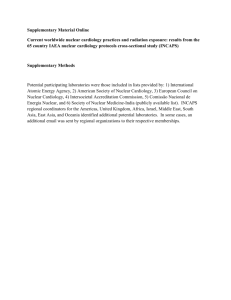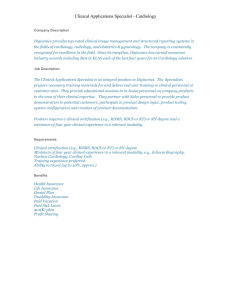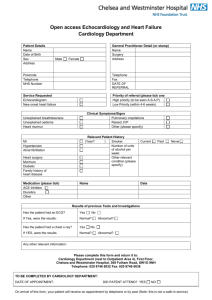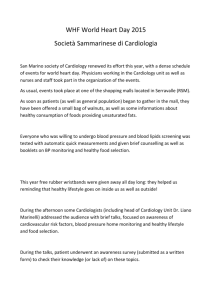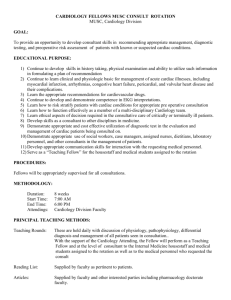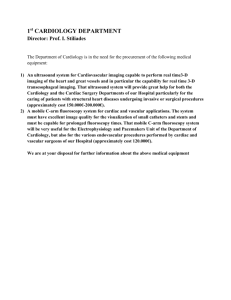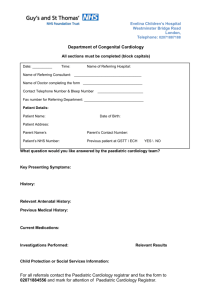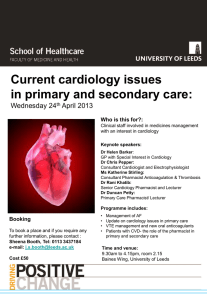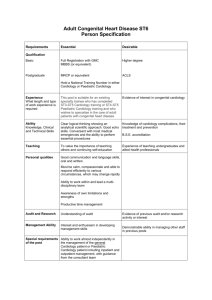Cardiology Fellow Responsibilities
advertisement
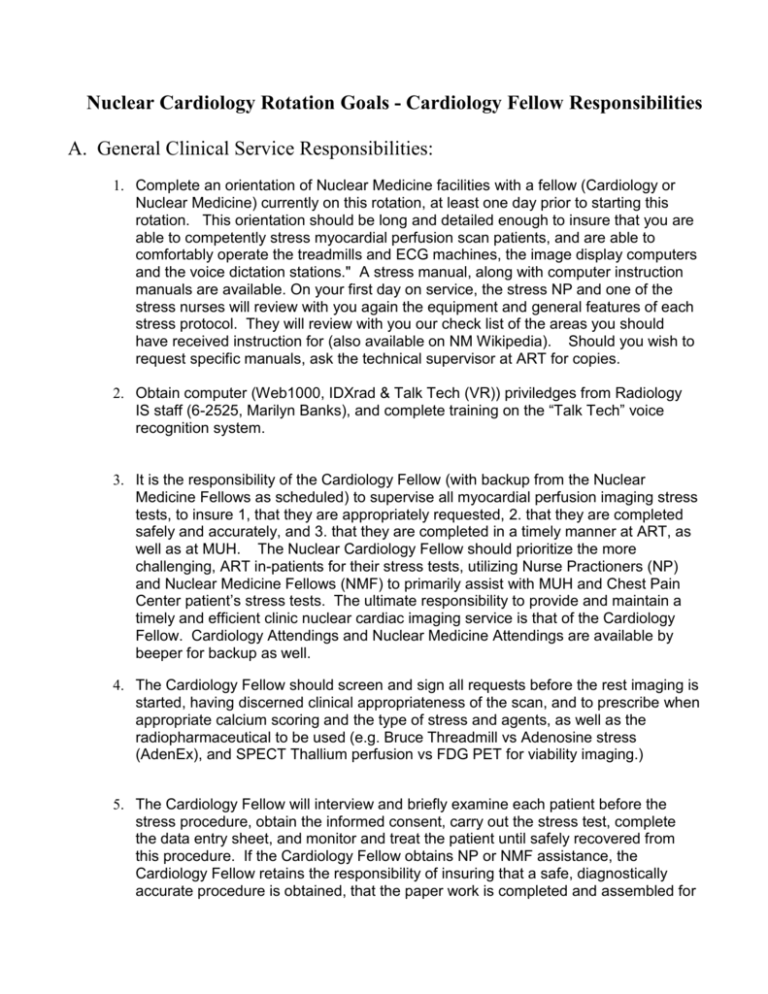
Nuclear Cardiology Rotation Goals - Cardiology Fellow Responsibilities A. General Clinical Service Responsibilities: 1. Complete an orientation of Nuclear Medicine facilities with a fellow (Cardiology or Nuclear Medicine) currently on this rotation, at least one day prior to starting this rotation. This orientation should be long and detailed enough to insure that you are able to competently stress myocardial perfusion scan patients, and are able to comfortably operate the treadmills and ECG machines, the image display computers and the voice dictation stations." A stress manual, along with computer instruction manuals are available. On your first day on service, the stress NP and one of the stress nurses will review with you again the equipment and general features of each stress protocol. They will review with you our check list of the areas you should have received instruction for (also available on NM Wikipedia). Should you wish to request specific manuals, ask the technical supervisor at ART for copies. 2. Obtain computer (Web1000, IDXrad & Talk Tech (VR)) priviledges from Radiology IS staff (6-2525, Marilyn Banks), and complete training on the “Talk Tech” voice recognition system. 3. It is the responsibility of the Cardiology Fellow (with backup from the Nuclear Medicine Fellows as scheduled) to supervise all myocardial perfusion imaging stress tests, to insure 1, that they are appropriately requested, 2. that they are completed safely and accurately, and 3. that they are completed in a timely manner at ART, as well as at MUH. The Nuclear Cardiology Fellow should prioritize the more challenging, ART in-patients for their stress tests, utilizing Nurse Practioners (NP) and Nuclear Medicine Fellows (NMF) to primarily assist with MUH and Chest Pain Center patient’s stress tests. The ultimate responsibility to provide and maintain a timely and efficient clinic nuclear cardiac imaging service is that of the Cardiology Fellow. Cardiology Attendings and Nuclear Medicine Attendings are available by beeper for backup as well. 4. The Cardiology Fellow should screen and sign all requests before the rest imaging is started, having discerned clinical appropriateness of the scan, and to prescribe when appropriate calcium scoring and the type of stress and agents, as well as the radiopharmaceutical to be used (e.g. Bruce Threadmill vs Adenosine stress (AdenEx), and SPECT Thallium perfusion vs FDG PET for viability imaging.) 5. The Cardiology Fellow will interview and briefly examine each patient before the stress procedure, obtain the informed consent, carry out the stress test, complete the data entry sheet, and monitor and treat the patient until safely recovered from this procedure. If the Cardiology Fellow obtains NP or NMF assistance, the Cardiology Fellow retains the responsibility of insuring that a safe, diagnostically accurate procedure is obtained, that the paper work is completed and assembled for the reading session, and that he/she is completely familiar with the patient and the stress test to facilitate the interpretation session. 6. Image processing (slice construction, attenuation correction and analysis) will be provided by the NMF and Nuclear Medicine technologists, but the Cardiology Fellow should complete these procedures on at least five patients during her/his rotation to insure working knowledge and familiarity with artifacts, and understanding of the limitations of nuclear imaging procedures. 7. The Cardiology Fellow is responsible for preliminary interpretation of the “Chest Pain” patient scans, and should as quickly as possible review these studies with the Nuclear Medicine Attending to reach a consensus before transmitting this preliminary interpretation to the Chest Pain Center referring attending physician. 8. The Cardiology Fellow is responsible for coordinating the afternoon scan interpretation session, including arranging appropriate Cardiology Attending and Nuclear Medicine Attending participation, assembling all MUH, ART and Outpatient (North Area and West Ashley) paperwork (requisitions, stress sheets, EKG’s etc), with the completed image files (insuring that all patient’s studies have been analysed with diagnostic images available on the computer worklist), logging the patient information and scan interpretations into the Nuclear Cardiology Book and into the Nuclear Cardiology Data Base Worksheet, and in the absence of NMF or Radiology resident, dictating the scan interpretation. 9. The Cardiology Fellow must phone all positive scan results to the referring physician. If repeated efforts at phoning the referring physician fail, then an email communication detailing the findings must be completed. 10. It is the responsibility of the Cardiology Fellow to assist, train and educate as needed the NMF, NP, nursing staff and NM technologists to insure safe and diagnostically accurate Nuclear Cardiac scanning procedures are completed daily. 11. The Cardiology Fellow’s work day begins prior to each 7:30 am Cardiology conference, with review and signing of study requisitions (this may also be completed during the late afternoon of the previous day). The first stress tests begins at approximately 8:30am. The Cardiology Fellow should contact the NM technologists to coordinate beginning the stress tests, so that there is not more than 5 minutes delay after completion of the rest scan. It is the responsibility of the Cardiology Fellow to maintain this communication so that smooth, and timely operation of the Nuclear Medicine service is preserved and patients experience the shortest possible waiting time. The Cardiology Fellow’s work day ends when all studies have been interpreted, the paper work completed, and the reports dictated. 12. It is expected that the Cardiology Fellow will complete a clinical research project during this three month rotation, and present it during the Nuclear Medicine Journal club. 13. Cardiology Fellow vacation time will be limited to one week during this rotation and must be signed off by both a Cardiology Attending and a Nuclear Medicine Attending. 14. When leaving the rotation, the Cardiology Fellow, at least one day prior to completion of this rotation, must orient and instruct the Cardiology Fellow(s) who follow, to competently stress myocardial perfusion scan patients, and to be able to operate the treadmills and ECG machines, the image display computers and the voice dictation stations. B. Specific Requirements for ACC/ASNC/SNM approved certification and NRC “Authorized User” of radioactive materials designation: 1. Satisfactory completion of a minimum of four months training in an ACGME approved program, including combined 700 hours of didactic, clinical study interpretations and hands on clinical case and radiation safety training. 2. Nuclear Medicine (both single and positron emitting) Cardiac lectures and self study should include in-depth details of myocardial perfusion imaging (MPI), gated blood pool ventriculography(MUGA), stress testing, viability imaging, infarct imaging, and nuclear cardiac shunt studies, and should include lectures and study incorporating the physics, instrumentation and clinical role of and correlative imaging with MR, CT and Echo. This must be completed over a 1224 month concurrent period during fellowship training. 3. A minimum of 80 hour of Radiation Safety classroom and laboratory (clinic) training must be completed with extensive review of radiation physics, instrumentation, radiation protection, and the mathematics required for safe, competent use and measurement of radioactive compounds. Thorough understanding of the radiochemistry of, radiobiology of and comprehension of the physiologic effects of ionizing radiation, as well as a thorough review of the Federal and SC regulations guiding the use of radiopharmaceuticals will be required and documented by a satisfactory, passing grade on the annual examination administered by MUSC Radiology physics staff. 4. During the four month rotation, Cardiology Fellows must be responsible for a minimum of 300 nuclear cardiac scans, all of which must be interpreted and reported with attending supervision. 5. During this four month rotation, Cardiology Fellows must have a hands-on, more direct role in the radiopharmaceutical preparation, stress test, scanning, data analysis (image processing), interpretation and reporting for a minimum of 25 MPI and 10 MUGA patients, and must document this experience in a logbook with study type, date and patient MRN recorded. 6. For each Cardiology (and Nuclear Medicine) Fellow, the required check list must be printed from the NM Wikipedia web site, and then signed by all designated individuals, with all items checked, prior to a NM Attending authoring and signing the Fellow’s Authorized User letter.
